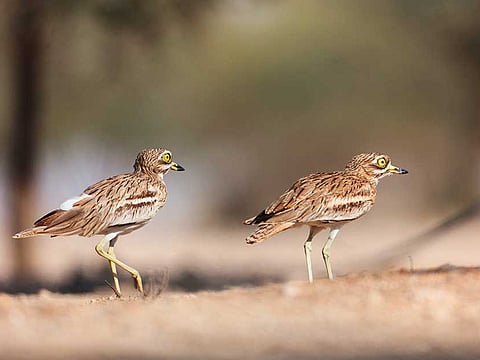UAE warns against poaching rare bird
Violating hunting ban on stone-curlew can result in six-month prison term, fine

Dubai: The Ministry of Climate Change and Environment is warning against using electronic devices that mimic bird calls to lure stone-curlew in the UAE.
The move follows an increase in poaching of the rare bird species during its winter migration through the country that poses a threat to its reproduction, the ministry said on Thursday.
The warning is in line with UAE legislation protecting the conservation of rare and endangered bird species.
Sultan Alwan, assistant undersecretary for the Regions Sector at the ministry, said: “The ministry has recently noticed that some people use electronic devices that imitate the voice of the stone-curlew to attract large numbers of these birds over long distances in order to catch them easily.”
Hunting stone-curlews is a violation of the Federal Law No. 24 of 1999 on the protection and development of the environment, amended as Federal Law No. 11 of 2006, and is punishable by imprisonment for a maximum period of six months and a fine of up to Dh20,000.
The illegal act also affects the UAE’s high ranking on the Global Environmental Competitiveness Index. In 2017, the country was placed 16th on the Environmental Legislation Implementation Index and the Index of Legislation Effectiveness and Strictness, as compared to the 19th and 18th ranks, respectively, on each index in 2014.
“The UAE will not allow such random individual misdemeanours to affect the unified efforts of government agencies, private sector and other segments of society.”
To combat poaching, the ministry is meeting with municipalities to put up signboards in wildlife areas and to begin education campaigns to protect the bird.
The ministry said it will also “review the regulations that control the import of bird song-replicating devices into the country.”
Stone-curlew
The stone-curlew (karawan in Arabic) is a desert bird and a winter migrant that appears in the UAE during March and October in semi-arid areas, on gravelly land and farms. Its greyish brown plumage provides effective camouflage, with distinctive white spots on the underside of the wings that are visible when flying.
The bird starts the migration journey from its home in Central Asia between late August and early November, and returns between early March and May. During this period, it often spends a few days in the UAE in search of the right climate, food and mating partners.
Sign up for the Daily Briefing
Get the latest news and updates straight to your inbox


